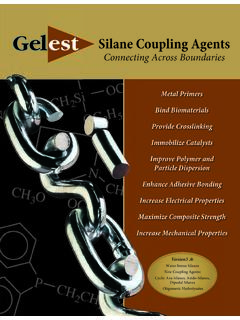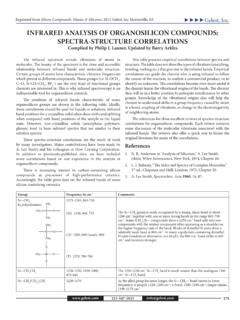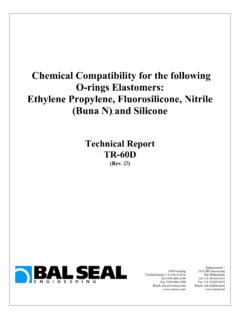Transcription of SILICONE FLUIDS - Gelest
1 MANUFACTURERS OF SILANES AND SILICONES2 Notes:All data on this table are for comparative classes of FLUIDS have a range of properties thatdo not represent the performance of an actual reported for FLUIDS including the paraffinhydrocarbon oil are without additives such as EPagents or stabilizers. Copyright 2012 Gelest , 8 ConventionalCommentSilicone FluidsThermal PropertiesHigh Temp C1,000 hours175 in air, Temp Cindefinite200 O2free, Temp Cpour point,-70 low valueRheological PropertiesViscosity, - PropertiesDielectric Strengthrange360-400volts/milDielectric Constantrange, PropertiesCompressibility, %@ 20,000 , PropertiesWater solubilityinsolubleHydrocarbonaromatic/s oluble/solubilityaliphaticpartialOptical PropertiesRefractive Index &Surface Tension, Propertiesdynes/cmWear/Lubricity PropertiesFour ball wear, mmat 75 C, 40 kg.
2 Load2-3steel on steel, one FLUIDSP roperty Profile GuideGelest, East Steel , PA 19067 Phone: (215) 547-1015 FAX: (215) (215) 547-1015 FAX: (215) OF CONTENTSI ntroduction .. 4 Definitions and Terms.. 5 Selection Guide.. 6 fluid Properties .. 8 SiBrid FLUIDS .. 26 Thermoplastic & Preceramic Materials.. 28 Refractive Indices of Pure FLUIDS .. 29 Viscosity Conversion Chart .. 30 Blending Chart .. 30 Page 16 Page 18 Page 20 Page 21 Page 23 TypicalOrganicHydrophilicLowHydrocarbonT hermalCompatibleFluorosiliconeand PolarTemperature(Paraffin) SILICONE FluidsSilicone FluidsFluidsSilicone FluidsSilicone FLUIDS Fluids260 150 190 135 235 130 280 230 260 -73 -50 -47 -50 -100 -30 50 - x105500 - 1x10480 - 1x10420-5,0004-400 400-420 175-200 300-400 OF SILANES AND SILICONES4 Gelest , FLUIDSS table Inert MediaAn introduction to SILICONE fluidsand their usesSilicone FLUIDS have unique properties because they are notproducts of petroleum or organic chemistry.
3 They were thefirst, and are still the only, major class of polymers that areproducts of inorganic chemistry. SILICONE FLUIDS consist of abroad range of different materials with the following charac-teristics: Wide Service Temperature Range Low Viscosity Changes vs. Temperature Thermal Stability Low Flammability Shear Stability Dielectric Stability High Compressibility Chemical Inertness Low Surface Tension Low ToxicityThese features have facilitated the adoption of silicones asdielectric, hydraulic, heat transfer, power transmission anddamping FLUIDS . They have found applications when incorpo-rated as additives into plastics and rubbers as process andrelease aids, into coatings for flow and level control and intoprocess streams as antifoams.
4 Other unique properties haveled to their introduction in acoustical applications such asultrasonic sensor and sonar buoys. Light refractive and indexmatching properties have allowed the use of silicones infiberoptics and optoelectronics. This proliferation of applica-tions has engendered many improvements and refinements ofsilicone FLUIDS can be divided into six general classes: Conventional Thermal FLUIDS ..16 Organic Compatible FLUIDS ..18 Fluorosilicone FLUIDS ..20 Hydrophilic Low Temperature FLUIDS ..23 The conventional FLUIDS , also referred to as polydimethylsilox-anes, exhibit all the properties of the SILICONE family. Theother classes of FLUIDS can be considered modifications of theconventional FLUIDS in which one set of properties has beenenhanced, but generally other properties are altered or (215) 547-1015 FAX: (215) Gelest , AND TERMSC entistokeA unit of kinematic viscosity, equaling 1 mm2 resistance offered by a real fluid to substance which undergoes continuous deformation when subjected to sheer Transition TemperatureThe temperature associated with a change from a glass state to a plastic state.
5 For silicones the Tg is usually substantially below room ViscosityDiffers from viscosity in that it is the measure of volume flow of a liquid, defined as astoke (St.) A stoke equals 1 or 10-4m2/sec. A centistoke, cSt. = .01 St. =1 Kinematic viscosity of a liquid (stokes) can be converted to viscosity(poise) by multiplying by the density of the FluidA fluid with consistency which varies as a function of shear stress as well astemperature and , the SI unit for viscosity, equalling 1 kg( ) or 10 ViscosityA measure of kinematic viscosity. To convert from SSU to St., apply the following for-mula for SSU > 100: St. = .00220(SSU) ViscosityFor a fluid polymer solution, the ratio of solution viscosity to solvent viscosity at thesame temperature; r= / consistency under fixed pressure and temperature of simple liquids orgases.
6 Perfect or ideal FLUIDS offer no resistance to shear and have zero dimensions are force per area x time. The unit of viscosity is the poise (p.)= 1g/(cm.)(sec.) and is a measure of mass flow of a liquid. One poise is equal s in SI CoefficientA measure of the change of fluid viscosity over the temperature range 38 C to 99 C; = 1-(viscosity @99 C/viscosity @ 38 C). Thus, the lower the the less thechange in viscosity over the temperature AND SPECIFICATIONSM olecular WeightsReported values are derived from kinematic viscosity measurements and correlate tonumber average molecular weight. GPC Number average molecular weights for dimethylsiloxanes have been related to polystyrene standards according to Pekala(American Laboratory 15, 4 1983): log Mw PDMS/MwPST = + ,where V is retention PercentagesAll copolymer percentages are mole %; graft and block polymer percentages areweight %.
7 ViscositiesReported values for kinematic viscosities for homopolymer FLUIDS are 10% for FLUIDS 100,000 cSt and 15% for FLUIDS >100,000 cSt. Reported viscosities for copolymerfluids are 20%.TemperatureWhen not indicated, reported properties for SILICONE FLUIDS are at 25 C ( K).R&D onlyIndicates that the product is not registered with the EPA for commercial or industrial use. Products not listed as R&D only are registered for industrial use -TSCA OF SILANES AND SILICONES6 Gelest , a SILICONE fluidThere are two approaches to selecting the proper siliconefluid for an application. The fluid class can be chosen bycomparing specific physical property requirements in theproperty profile by class chart located inside the front coveror by comparing function and application requirements in thefollowing table.
8 Once the fluid class is selected, a specificgrade can be determined on the next few pages by followingthe color fluid Selection GuideFunctionApplicationFluid ClassDielectricTransformers, Rectifiers ConventionalCoolant/FluidCapacitorsMagne tron Conventional ThermalDielectric Impregnation Conventionalof Porous SubstrateLubricationMold Release Conventional Organic Compatible EmulsionAluminum Machining Organic Compatibleand ExtrudingDie Casting Organic CompatibleBall Bearing and Gear Organic CompatibleLubrication Thermal FluorosiliconeAirborne Radar Low TemperatureRubber/Plastic Contact Conventional Organic CompatibleFiber/Plastic Contact HydrophilicMetal/Plastic Contact Organic Compatible Thermal FluorosiliconeMetal/Metal Contact Organic Compatible Thermal (Chlorophenyl)Grease Conventional, Thermal or Fluorosilicone7(215) 547-1015 FAX.
9 (215) Gelest , ClassWorking MediaFluid Clutch Conventional ThermalSmart FLUIDS Conventional Organic CompatibleHydraulic fluid Low Temperature, Conventional ThermalBrake fluid Conventional (Intermediate Viscosity)Shock Absorber Conventional Thermal orGeneral Damping Conventional Thermal FluorosiliconeMeter Damping ConventionalTiming Devices Conventional ThermalMagnetic Amplifier ThermalDiffusion Pump Thermal (Oligomeric)PerformanceSurfactant/Antifo am Conventional (Low Viscosity),Additive Hydrophilic FluorosiliconeHydrocarbon compatibility Organic CompatibleFlow Control Conventional (Low Viscosity)Wetting HydrophilicRadiation Resistance ThermalAcousticalSonobuoy Conventional (Reduced Volatility)Sound Coupling/Lensing FluorosiliconeOpticalOptical Coupling fluid ThermalAnti-fog Agent HydrophilicGloss Enhancement Conventional (Low-Intermediate Viscosity)Heat TransferHeat Treatment Bath ThermalConstant Temperature Bath Conventional (Intermediate Viscosity) ThermalTemperature Measurement Conventional, (Intermediate Viscosity)
10 ,Device Thermal FluorosiliconeClosed Loop Heating ThermalRefrigerated Systems Low Temperature Gelest , OF SILANES AND SILICONES8 Conventional SILICONE FluidsConventional FLUIDS are the well-knowngeneral purpose silicones described inchemical notation as polydimethylsilox-anes. They are commercially producedin viscosities ranging from to2,500,000 SILICONE FLUIDS are com-posed of polymer chains with uniqueflexibility. Polydimethylsiloxane has vir-tually no energy barrier for results in one of the lowest glass-transition temperatures of any liquid surface tension of polydi-methylsiloxane is lower than the criticalsurface tension of wetting (24dynes/cm).







